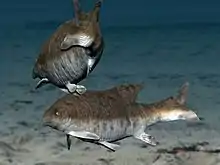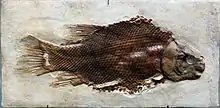Scheenstia
Scheenstia is an extinct genus of neopterygian ray-finned fish from the Late Jurassic–Early Cretaceous periods. Fossils have been found in Bavaria, France, and England.

| Scheenstia | |
|---|---|
 | |
| Fossil specimen of S. maxima | |
| Scientific classification | |
| Kingdom: | Animalia |
| Phylum: | Chordata |
| Class: | Actinopterygii |
| Order: | †Semionotiformes |
| Family: | †Semionotidae |
| Genus: | †Scheenstia López-Arbarello & Sferco, 2011 |
| Type species | |
| Scheenstia zappi López-Arbarello & Sferco, 2011 | |
| Species[1] | |
|
†S. mantelli (Agassiz, 1833) | |
Scheenstia is frequently pictured as the prey of the dinosaur Baryonyx walkeri because the scales and teeth of these fish were found in the stomach region of a fossil B. walkeri specimen. The fish remains were previously referred to the related genus Lepidotes, but all Late Jurassic–Early Cretaceous species of that genus have since been re-classified as Scheenstia following detailed phylogenetic analysis.[1]
Classification
Scheenstia is related to the genus Lepidotes. The latter has been one of the greatest actinopterygian wastebasket taxa, with one 2012 study finding species referrable to a minimum of three different and distantly related genera. Scheenstia is also related to Isanichthys. A cladogram showing the relations of Neopterygii was published in the review, and a simplified version labelling the previous species of Lepidotes is shown here.[1]
| Ginglymodi |
| ||||||||||||||||||||||||||||||||||||||||||||||||||||||||||||||||||||||||||||||||||||||||||
References
- López-Arbarello, A. (2012). "Phylogenetic Interrelationships of Ginglymodian Fishes (Actinopterygii: Neopterygii)". PLoS ONE. 7 (7): e39370. doi:10.1371/journal.pone.0039370. PMC 3394768. PMID 22808031.